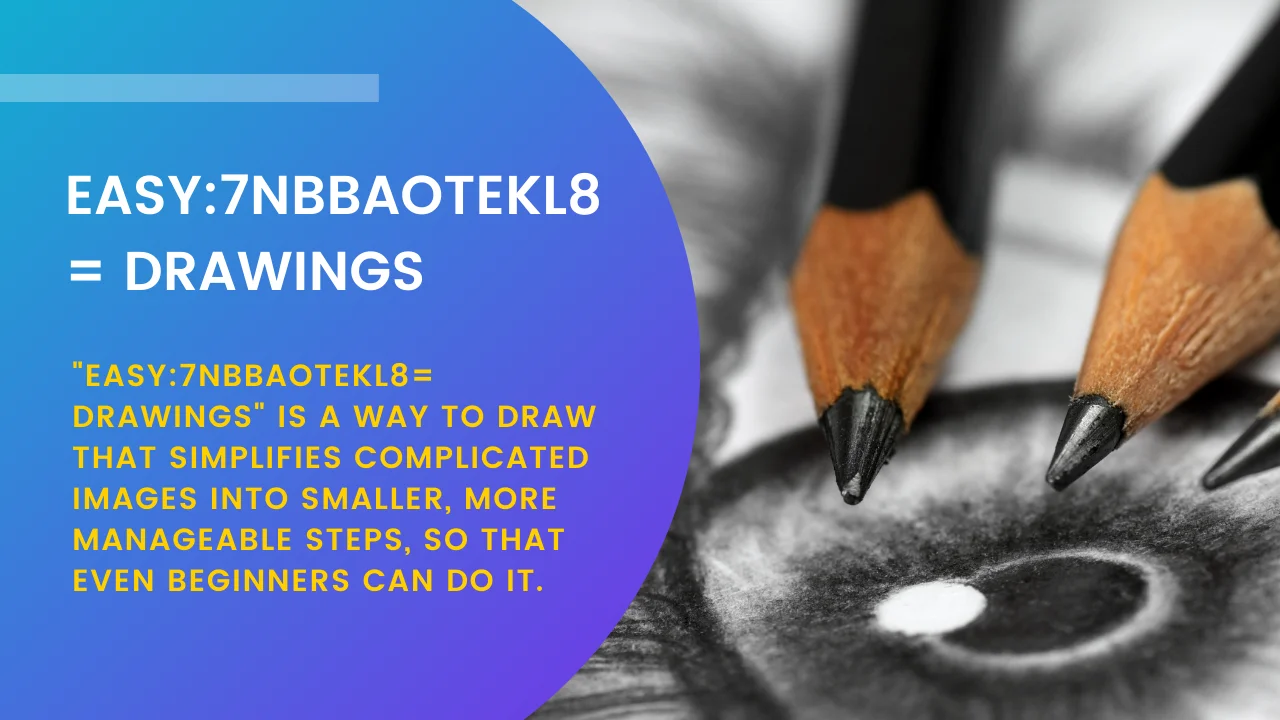Introduction
Many people wish they could draw well, but the prospect can be overwhelming for those just starting out. The idea of “easy:7nbbaotekl8= drawings” streamlines the procedure by dividing intricate pictures into more manageable portions. Everyone, especially those unfamiliar with the art form, will be able to draw with the help of this method. In this article, we’ll look at a number of ways to simplify and enjoy the drawing process. In this all-inclusive drawing tutorial, we’ll go over the fundamentals (lines and shapes) as well as more complex topics (shading and texture).
What is Easy:7nbbaotekl8= Drawings?
“Easy:7nbbaotekl8= drawings” is a way to draw that simplifies complicated images into smaller, more manageable steps, so that even beginners can do it. This approach is designed to help students develop their drawing abilities by following a seven-step process.
Mastering Basic Shapes
Grasping the fundamentals of shapes is the first step in becoming a skilled artist. Any aspiring artist must have a firm grasp of these forms because they lay the groundwork for more intricate images.
Understanding Circles and Ovals
The two most basic forms in drawing are the circle and the oval. They form the framework of countless things, from faces to wheels. You can improve your ability to draw complex curves by practicing on simple shapes like circles and ovals.
Drawing Squares and Rectangles
Buildings, books, and countless other things rely on squares and rectangles as their foundation. If you want to draw balanced and accurate pictures, you need to learn about proportion and symmetry, which you can do by practicing with these forms.
Triangles and Polygonal Shapes
To make drawings that are more lively and organized, polygons like triangles are necessary. They are useful for laying the groundwork for more intricate structures by constructing the skeleton of different objects.
Combining Basic Shapes
Learning to work with simple shapes will make it much easier to combine them to create more intricate designs. By honing your capacity to conceptualize and build drawings from the bottom up, this technique can help you draw more intuitively.
Refining Lines and Curves
A drawing isn’t complete without lines and curves. If you want to make pictures that pop, you need to master these elements.
Practicing Straight Lines
Edges and the structure of objects are defined by straight lines. Mastering the art of freehand straight line drawing is a great way to hone the control and accuracy needed for intricate details.
Mastering Curved Lines
Drawings with curved lines have more life and movement. They show human figures, animals, and plants in their natural habitats. You can improve your drawing skills and make your subjects look more realistic by practicing curved lines.
Exploring Line Weight
Line weight is the measure of a line’s thickness or thinness. Drawings are made more interesting and eye-catching when the line weight is varied. If you want your drawings to have more personality and energy, try playing around with various line weights.
Creating Dynamic Strokes
Strokes with varying weights, both straight and curved, create movement. You can make your drawings more expressive and lifelike by using this method. It will also give your artwork more energy and movement.
Shading Techniques
To give your drawings more depth and dimension, shading is an essential drawing technique. To draw more realistic and detailed scenes, it helps to know how to use various shading techniques.
Hatching and Cross-Hatching
To make hatching look like shading, you draw parallel lines. To achieve a more dramatic shading effect, cross-hatching involves the use of intersecting sets of parallel lines. These methods work wonders for giving drawings a sense of depth and texture.
Stippling and Blending
Stippling is the practice of using tiny dots to simulate shading. As the dots get closer together, the shading becomes darker. Conversely, blending is achieving a gradient effect by reducing the sharpness of the shading. You can add a variety of textures and effects to your drawings using either method.
Understanding Light and Shadow
If you want your shading to look realistic, you need to know how light and shadow work together. In order to draw objects more accurately and realistically, it is helpful to study the effects of different light sources on them.
Creating Depth with Shading
Adding darkness is only part of shading; it’s also about giving an image more depth and dimension. Create the illusion of depth and realism in your drawings by skillfully manipulating light, shadow, and midtones through shading.
Creating Textures
Drawings with textures are more interesting and lifelike because of the tactile quality they impart. Improving your artwork’s quality is as simple as learning to depict different textures.
Drawing Rough Textures
Irregular patterns and sharp lines are great ways to represent rough textures like tree bark or rocky surfaces. Using these methods consistently allows one to draw with greater depth and realism.
Depicting Smooth Textures
You need to change your strategy when dealing with smooth materials like metal or glass. It is possible to give the impression of smooth surfaces by using blending techniques and smooth, continuous lines.
Exploring Varied Textures
You can improve your drawing abilities and give your artwork more depth by experimenting with different textures, such as smooth fur and rough concrete. A wide range of textures can be achieved by experimenting with different techniques and tools.
Adding Realism with Textures
Drawings are made more realistic with textures because they show the material characteristics of objects. Improving the quality and realism of your artwork is as simple as studying real-life textures and practicing how to mimic them in your drawings.
Understanding Perspectives
To give drawings a feeling of depth and space, perspective is crucial. If you want your images to look more realistic and lively, you should learn and practice perspective techniques.
One-Point Perspective
The most basic kind of perspective is known as one-point perspective, and it involves drawing all lines of sight to a single horizon point. To give drawings the appearance of depth, this technique is employed.
Two-Point Perspective
In a two-point view, the horizon is split in half by two vanishing points. If you want to give your drawings of buildings and other structures a more alive feel, try this method.
Three-Point Perspective
Typically placed either above or below the horizon, a third vanishing point is added in three-point perspective. You can add a dramatic sense of depth to your drawings by using this technique to depict scenes from an elevated or lowered viewpoint.
Applying Perspective in Drawings
Realistic and proportionate drawings can be achieved by utilizing perspective techniques. Your skill in accurately representing depth and space will improve as you practice these techniques.
Proportions and Anatomy
If you want your drawings of people and animals to look realistic, you need to study anatomy and proportions. Having a firm grasp of these ideas allows one to make drawings that are both realistic and lively.
Understanding Human Proportions
Accurately depicting human forms requires knowledge of human proportions. Studying and practicing human anatomy helps in achieving accurate proportions and poses.
Drawing Animal Anatomy
The human body is very different from an animal’s. To draw animals realistically, it is helpful to study their anatomy and body proportions.
Proportions in Objects
Drawing objects accurately also requires an understanding of proportions, which are not exclusive to living things. Drawing realistically requires an understanding of the proportions of commonplace objects.
Practicing Proportion Techniques
You can improve your skills in drawing balanced and accurate images by consistently practicing proportional techniques. This process can be facilitated with the use of reference materials and manuals.
Adding Details and Finishing Touches
Add life to your drawings with details and finishing touches. These components make your artwork more interesting and realistic, which in turn makes it more engaging and professional.
Highlighting Key Features
The eyes in a portrait or the leaves on a tree are two examples of key features that can be highlighted to draw attention to important parts of your drawing. Paying close attention to these details will make your artwork stand out more.
Adding Texture Details
To make your drawings more lifelike and realistic, try adding details with different textures, like fur or fabric. Images that are more detailed and realistic can be achieved through the practice of these techniques.
Creating Highlights and Shadows
Drawing with highlights and shadows gives your artwork more depth. Your artwork will have more depth and realism if you use these elements to represent light and dark areas.
Finishing Touches for Realism
Fine lines, tiny details, and delicate shading are the finishing touches that finish off your drawing and give it that professional look. The key to making top-notch art is paying close attention to these details.
Engaging in Easy Drawing Techniques
Relaxation, enhanced concentration, and increased self-assurance are just a few of the many advantages of practicing simple drawing techniques. In order to develop their skills in a structured and enjoyable manner, artists can begin with simple subjects and progressively add more complexity. If you want to get better at drawing, you need to practice often, consult references, and try out new styles and techniques.
Frequently Asked Questions
How to draw basic shapes step-by-step?
Drawing basic shapes step-by-step involves starting with simple outlines and gradually adding details. Begin with a light sketch of the basic shape, refine the lines, and then add shading and texture as needed.
What are simple drawing techniques for beginners?
Simple drawing techniques for beginners include practicing basic shapes, lines, and curves, experimenting with shading and textures, and using reference images to guide your drawings. Regular practice and experimenting with different tools and techniques help in improving your skills.
How to create realistic drawings easily?
Creating realistic drawings easily involves understanding and practicing shading, perspective, and proportions. Using reference images and practicing regularly helps in achieving realistic and detailed drawings.
What are the benefits of easy drawing techniques?
The benefits of easy drawing techniques include stress relief, improved focus and concentration, enhanced creativity, and a sense of accomplishment. Drawing can also improve hand-eye coordination and fine motor skills.
How to improve drawing skills with simple methods?
Improving drawing skills with simple methods involves regular practice, studying and replicating reference images, experimenting with different techniques and tools, and seeking feedback from other artists. Consistent practice and learning from mistakes help in continuous improvement.
Also Read: Drawing:yw-tzomiaao= heart
Conclusion
The path to drawing mastery is a rewarding and approachable one, particularly when one uses the “easy:7nbbaotekl8= drawings” method. The key to helping anyone develop their artistic abilities is to simplify complicated images into simple steps. A beginner can become a confident and skilled artist with regular practice, patience, and an openness to exploring different techniques. Embrace the journey of creativity and marvel at your skills as they blossom.

Karen Altizer is a seasoned professional with a wealth of expertise in marketing and communications, adept at crafting compelling narratives and strategic messages tailored to various stakeholders.

